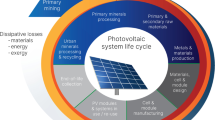Abstract
Fourteen new energy-efficient and environmentally acceptable catalytic processes have been identified that can use excess high-purity carbon dioxide as a raw material available in a chemical production complex. The complex in the lower Mississippi River Corridor was used to show how these new plants could be integrated into this existing infrastructure using the chemical complex analysis system. Eighty-six published articles of laboratory and pilot plant experiments were reviewed that describe new methods and catalysts to use carbon dioxide for producing commercially important products. A methodology for selecting the new energy-efficient processes was developed based on process operating conditions, energy requirements, catalysts, product demand and revenue, market penetration and economic, environmental and sustainable costs. Based on the methodology for selecting new processes, 20 were identified as candidates for new energy efficient and environmentally acceptable plants. These processes were simulated using HYSYS, and a value-added economic analysis was evaluated for each process. From these, 14 of the most promising were integrated in a superstructure that included plants in the existing chemical production complex in the lower Mississippi River corridor (base case). The optimum configuration of plants was determined based on the triple bottom line that includes sales, economic, environmental and sustainable costs using the chemical complex analysis system. From 18 new processes in the superstructure, the optimum structure had seven new processes including acetic acid, graphite, formic acid, methylamines, propylene and synthesis gas production. With the additional plants in the optimal structure the triple bottom line increased from $343 million per year to $506 million per year and energy use increased from 2,150 TJ/year to 5,791 TJ/year. Multicriteria optimization has been used with Monte Carlo simulation to determine the sensitivity of prices, costs, and sustainability credits/cost to the optimal structure of a chemical production complex. In essence, for each Pareto optimal solution, there is a cumulative probability distribution function that is the probability as a function of the triple bottom line. This information provides a quantitative assessment of the optimum profit versus sustainable credits/cost, and the risk (probability) that the triple bottom line will meet expectations. The capabilities of the chemical complex analysis system have been demonstrated, and this methodology could be applied to other chemical complexes in the world for reduced emissions and energy savings. The system was developed by industry–university collaboration, and the program with users manual and tutorial can be downloaded at no cost from the LSU Mineral Processing Research Institute’s website http://www.mpri.lsu.edu.




Similar content being viewed by others
References
Arakawa H (1998) Research and development on new synthetic routes for basic chemicals by catalytic hydrogenation of CO2. Advances in chemical conversions for mitigating carbon dioxide. Stud Surf Sci Catal 114:19–30
Arakawa H et al (2001) Catalyst research of relevance to carbon management: progress, challenges and opportunities. Chem Rev 101:953–996
Bonivardi AL, Chiavassa DL, Baltanas MA (1998) Promoting effect of calcium addition to Pd/SiO2 catalysts in CO2 hydrogenation to methanol. Advances in chemical conversions for mitigating carbon dioxide. Stud Surf Sci Catal 114:533–536
C &EN (2003) World’s largest dehydrogenation plant begins trial operations. Chemical & Engineering News, p 15
Camford Chemical Prices (2000) Camford chemical report/chemical prices. Camford Information Services, August 28
Chemical Market Reporter (2000) Methylamines. Chemical Market Reporter, April 24
Chemical Market Reporter (2002a) Prices and people. Chemical Market Reporter, February 4
Chemical Market Reporter (2002b) BASF to increase price. Chemical Market Reporter, April 1
Chemical Market Reporter (2003) Prices and people.’ Chemical Market Reporter, February 10
Constable D et al (1999) Total Cost Assessment Methodology; Internal Managerial Decision Making Tool, AIChE/TCA Report. American Institute of Chemical Engineers, vol 3, New York, 2000
Creutz C, Fujita E (2000) Carbon Dioxide as a Feedstock. In: Carbon management: implications for R&D in the chemical sciences and technology: a workshop report to the chemical sciences roundtable. The National Academies Press, Washington
Dinjus E (1998) Organometallic reactions with CO2—catalyst design and mechanisms. Advances in chemical conversions for mitigating carbon dioxide. Stud Surf Sci Catal 114:127–140
Dodge BF (1944) Chemical engineering thermodynamics. McGraw-Hill, New York
EIA (2000a) Emissions of greenhouse gases in the United States 2000 Executive Summary. http://www.eia.doe.gov/oiaf/1605/gg01rpt/executive_summary.html (accesses May 2003).
EIA (2000b) Carbon dioxide emissions, http://www.eia.doe.gov/oiaf/1605/gg01rpt/carbon.html (accessed May 2003)
EIA (2001) Energy-related carbon dioxide emissions in manufacturing. http://www.eia.doe.gov/oiaf/1605/ggrpt/carbonb.html (accessed June 2003)
Flannery BP (2000) An industry perspective on carbon management. In: Carbon management: implications for R&D in the chemical sciences and technology: a workshop report to the chemical sciences roundtable. The National Academies Press, Washington, pp 44–59
Freguia S et al (2003) Modeling of CO2 capture by aqueous monoethanolamine. AIChE 49(7):1676–1685
Haruki E (1982) Organic synthesis with carbon dioxide. Organic and bio-organic chemistry of carbon dioxide. Wiley, New York
Hertwig TA, Xu A, Indala S, Pike RW, Knopf FC, Hopper JR, Yaws CL (2002) Integrated chemical complex and cogeneration analysis system: energy conservation and greenhouse gas management solutions. In: Proceedings of the sustainable engineering topical conference, sustainable design methodology, AIChE Annual Meeting, Paper No. 19f, 3–8 November 2002, Indianapolis
Higuchi K, Haneda Y, Tabata K, Nakahara Y, Takagawa M (1998) A study for the durability of catalysts in ethanol synthesis by hydrogenation of carbon dioxide. Advances in chemical conversions for mitigating carbon dioxide. Stud Surf Sci Catal 114:517–520
Indala S (2004) Development and integration of new processes consuming carbon dioxide in multi-plant chemical production complexes. MS Thesis, Louisiana State University
Inoue S, Yamazaki N (1982) Organic and bio-organic chemistry of carbon dioxide. Wiley, New York
Inui T et al (1998) Advances in chemical conversions for mitigating carbon dioxide. In: Proceedings of the 4th international conference on carbon dioxide utilization. Studies in surface science and catalysis, vol 114. Elsevier, Amsterdam
Inui T (2002) Effective conversion of CO2 to valuable compounds by using multifunctional catalysts. In: ACS symposium series, 809 CO2 conversion and utilization, pp 130–152
Jun KW, Jung MH, Rao KS, Choi MJ, Lee W (1998) Effective conversion of CO2 to methanol and dimethyl ether over hybrid catalysts. Advances in chemical conversions for mitigating carbon dioxide. Stud Surf Sci Catal 114:447–450
Jun KW, Lee HS, Roh HS, Park SE (2002) Catalytic dehydration of methanol to dimethyl ether (DME) over solid–acid Catalysts. Bull Korean Chem Soc 23(6):803–806
Keene FR (1993) Thermodynamic, kinetic, and product considerations in carbon dioxide reactivity. In: Sullian BP, Krist K, Guard HE (eds) Electrochemical and electrocatalytic reactions of carbon dioxide, Chap 1. Elsevier, Amsterdam
Kim SH, Edmonds JA (2000) Potential for advanced carbon capture and sequestration technologies in a climate constrained world, PNNL –13095. Pacific Northwest National Laboratory
Louisiana Chemical & Petroleum Products List, (1998) Office of policy and research. Louisiana Department of Economic Development, Baton Rouge
Mimura N, Takahara I, Saito M, Hattori T, Ohkuma K, Ando M, (1998) Dehydrogenation of ethylbenzene over iron oxide-based catalyst in the presence of carbon dioxide. Advances in chemical conversions for mitigating carbon dioxide. Stud Surf Sci Catal 114:415–418
Moulijn JA, Makkee M, Van Diepen A (2001) Chemical process technology. Wiley, New York
Nerlov J, Chorkendorff I (1999) “Methanol Synthesis from CO2, CO, and H2 over Cu(100) and Ni/Cu(100)”. J Catal 181:271–279
Nishiguchi H, Fukunaga A, Miyashita Y, Ishihara T, Takita Y, (1998) Reduction of carbon dioxide to graphite carbon via methane by catalytic fixation with membrane reactor. Advances in chemical conversions for mitigating carbon dioxide. Stud Surf Sci Catal 114:147–152
Ondrey G (2003) A process to make methanol from CO2. Chem Eng 110(10):17
Pellegrino JL (2000) Energy and Environmental Profile of the US Chemical Industry. US DOE, Office of Industrial Technologies, Washington, DC
Peterson RW (1999) Giants on the river. Homesite Company, Baton Rouge
Sakurai Y, Suzaki T, Nakagawa K, Ikenaga NO, Aota H, Suzuki T (2000) Oxidation capability of carbon dioxide in the dehydrogenation of ethylbenzene over vanadium oxide-loaded MgO Catalyst. Chem Lett 5:526–527
Shamsi A (2002) Methane dry reforming over carbide, nickel-based, and noble metal catalysts. ACS Symposium Series, vol 809. CO2 conversion and utilization, pp 182–196
Simmonds M et al (2002) Amine based CO2 capture from flue gas. In: Annual meeting, September 2002, Gas Processors Association Europe
Smith JM, Van Ness HC, Abbott MM (1996) Introduction to chemical engineering thermodynamics, 5th edn. McGraw-Hill, New York
Song C, Gaffney AF, Fujimoto KF (2002) CO2 conversion and utilization, ACS Symposium Series 809, Chap 1. American Chemical Society Oxford University Press, Washington
Song C, Srimat ST, Murata S, Pan W, Sun L, Scaroni AW, Armor JN (2002) Effects of pressure on CO2 reforming of CH4 over Ni/Na-Y and Ni/Al2O3 catalysts. ACS symposium Series, 809,CO2 conversion and utilization, pp 258–274
Steinberg M, Halmann MM (1999) Greenhouse gas carbon dioxide mitigation. Lewis Publishers, Washington
Sullivan BP et al (1993) Electrochemical and electrocatalytic reactions of carbon dioxide. Elsevier, Amsterdam
Takahara I, Chang WC, Mimura N, Saito M (1998) Promoting effects of CO2 on dehydrogenation of propane over a SiO2-supported Cr2O3 catalyst. Advances in chemical conversions for mitigating carbon dioxide. Stud Surf Sci Catal 114:419–422
Taniguchi Y, Hayashida T, Kitamura T, Fujiwara Y (1998) “Vanadium-catalyzed acetic acid synthesis from methane and carbon dioxide”. Advances in chemical conversions for mitigating carbon dioxide. Stud Surf Sci Catal 114:439–442
Tomishige K, Chen Y, Li X, Yokoyama K, Sone Y, Yamazaki O, Fujimoto K (1998) Development of active and stable nickel-magnesia solid solution catalysts for CO2 reforming of methane. Advances in chemical conversions for mitigating carbon dioxide. Stud Surf Sci Catal 114:375–378
Toyir J, Saito M, Yamauchi I, Luo S, Wu J, Takahara I, Takeuchi M (1998) Development of high performance Raney copper-based catalysts for methanol synthesis from CO2 and H2”. Advances in chemical conversions for mitigating carbon dioxide. Stud Surf Sci Catal 114:267–272
Turton R, Bailie RC, Whiting WB, Shaeiwitz JA (1998) Analysis, synthesis, and design of chemical processes, 2nd edn. Prentice Hall, New Jersey
Ushikoshi K, Mori K, Watanabe T, Takeuchi M, Saito M (1998) A 50 kg/day class test plant for methanol synthesis from CO2 and H2. Advances in chemical conversions for mitigating carbon dioxide. Stud Surf Sci Catal 114:357–362
Wei JM, Xu BQ, Li JL, Cheng ZX, Zhu QM (2002) A highly active and carbon resistant catalyst for CH4 reforming with CO2: nickel supported on an ultra-fine ZrO2. ACS symposium series, vol 809, CO2 conversion and utilization, pp 197–204
Xu A et al (2003) Identifying and developing new, carbon dioxide consuming processes. In: AIChE annual meeting, Paper No 408b, 16–21 November 2003, San Francisco
Xu A (2004) Chemical production complex optimization, pollution reduction and sustainable development. PhD Dissertation, Louisiana State University
Xu A et al (2004) Chemical complex analysis system users manual and tutorial. Minerals Processing and Research Institute. Louisiana State University
Author information
Authors and Affiliations
Corresponding author
Rights and permissions
About this article
Cite this article
Xu, A., Indala, S., Hertwig, T.A. et al. Development and integration of new processes consuming carbon dioxide in multi-plant chemical production complexes. Clean Techn Environ Policy 7, 97–115 (2005). https://doi.org/10.1007/s10098-004-0270-y
Received:
Accepted:
Published:
Issue Date:
DOI: https://doi.org/10.1007/s10098-004-0270-y




